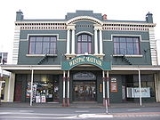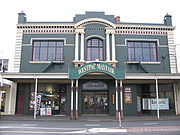
Mayfair Theatre, Dunedin
Encyclopedia

Dunedin
Dunedin is the second-largest city in the South Island of New Zealand, and the principal city of the Otago Region. It is considered to be one of the four main urban centres of New Zealand for historic, cultural, and geographic reasons. Dunedin was the largest city by territorial land area until...
, New Zealand
New Zealand
New Zealand is an island country in the south-western Pacific Ocean comprising two main landmasses and numerous smaller islands. The country is situated some east of Australia across the Tasman Sea, and roughly south of the Pacific island nations of New Caledonia, Fiji, and Tonga...
, was opened on December 8, 1914 as the "King Edward Picture Theatre". It is owned by the Dunedin Opera Company and serves as a 400 seat venue for live performances for a number of local community groups and as the Dunedin venue for some touring agencies.
It is located in King Edward Street, South Dunedin
South Dunedin
South Dunedin is a major inner city suburb of the New Zealand city of Dunedin. It is located, as its name suggests, to the south of the city centre, on part of a large plain known locally simply as "The Flat". The suburb is a mix of industrial, retail, and predominantly lower-quality residential...
, close to the crossroads known as Cargill's Corner.
It was built as a purpose-designed cinema in 1914 by the King Edward Picture Theatre Company. This included some people prominent in Dunedin business such as William and Mary Ann Hudson of the eponymous confectionery company, the brewer Charles Speight and Robert and Charles Greenslade, also of the brewery (Speight's
Speight's
Speight's is a brewery in Dunedin, New Zealand. It is famous for its promotional branding based on being 'a real southern man' and being 'the pride of the south'. Speight's also gave rise to a series of Speight's Ale Houses across New Zealand.- History :...
).
The name overtly associated with the building's design is Edward Walter Walden, (d.1944) but it seems to reflect the expertise and personal touch of Edmund Anscombe
Edmund Anscombe
Edmund Anscombe was one of the most important figures to shape the architectural and urban fabric of New Zealand. He was important, not only because of the prolific nature of his practice and the quality of his work, but also because of the range and the scale of his built and speculative projects...
(1874-1948). This was early in the history of purpose-designed cinemas. While live venues had fan-shaped auditoria and deep stages behind the proscenium arch the Mayfair has the characteristic rectangular auditorium and originally small space behind the proscenium of a cinema. It was decorated with exuberant plasterwork by Robert Wardrop (1858-1924) which remains a striking feature of the interior. There are solemn faced caryatids, resembling respectable Dunedin matrons and personalised naked putti.
It was modified for sound in 1934 and renamed the Mayfair Theatre. The proscenium was altered, as was some plasterwork and new stained glass windows were introduced, in a re-fit designed by Llewellyn E. Williams. It was closed as a cinema on the 25th of September 1966.
The building was acquired by the Dunedin Opera Company in 1967 which converted it to a live venue. The seating capacity was reduced from 862 to 413 by removing the ground floor stalls and advancing the proscenium into the auditorium to achieve a greater stage depth. It has since been operated as a live theatre, particularly for opera.
By 2008 it was one of only three remaining buildings in New Zealand originally purpose-designed as cinemas, with the Princess Theatre in Gore, New Zealand
Gore, New Zealand
Gore is a town, surrounding borough, and district in the Southland region of the South Island of New Zealand.-Geography:The Gore District has a land area of 1,251.62 km² and a resident population of...
(1913) and the Victoria Theatre in Devonport
Devonport, New Zealand
Devonport is a harbourside suburb of Auckland, New Zealand. It is located on the North Shore, at the southern end of a peninsula that runs southeast from near Lake Pupuke in Takapuna, forming the northern side of the Waitemata Harbour...
, Auckland (1912).
In 2008, a $20,000 state-of-the-art fire alarm system was installed with donations from several charities. Previously the code phrase "Mr Sands to report to the dressing rooms" would have been used to evacuate the building, but this was eventually disallowed by the Fire Service
New Zealand Fire Service
The New Zealand Fire Service is New Zealand's national fire fighting body. While its founding legislation, the Fire Service Act 1975, only provides for this role, the organisation has assumed responsibility for several other areas.-Strategic Direction:The New Zealand Fire Service has defined for...
as not meeting legal requirements.
On 5 December 2008 the theatre was registered by the New Zealand Historic Places Trust as a Category II historic place.

